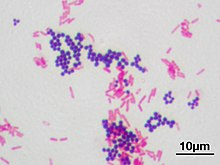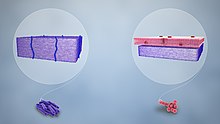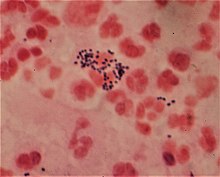Gram stain


Gram stain(Gram stainingorGram's method), is a method ofstainingused to classifybacterialspecies into two large groups:gram-positive bacteriaandgram-negative bacteria.It may also be used to diagnose afungal infection.[1]The name comes from the DanishbacteriologistHans Christian Gram,who developed the technique in 1884.[2]
Gram staining differentiates bacteria by the chemical and physical properties of theircell walls.Gram-positive cells have a thick layer ofpeptidoglycanin the cell wall that retains the primary stain,crystal violet.Gram-negative cells have a thinner peptidoglycan layer that allows the crystal violet to wash out on addition ofethanol.They are stained pink or red by thecounterstain,[3]commonlysafraninorfuchsine.Lugol's iodinesolution is always added after addition of crystal violet to strengthen the bonds of the stain with thecell membrane.
Gram staining is almost always the first step in the identification of a bacterial group. While Gram staining is a valuable diagnostic tool in both clinical and research settings, not all bacteria can be definitively classified by this technique. This gives rise togram-variableandgram-indeterminategroups.
History
[edit]The method is named after its inventor, theDanishscientistHans Christian Gram(1853–1938), who developed the technique while working withCarl Friedländerin the morgue of the city hospital inBerlinin 1884. Gram devised his technique not for the purpose of distinguishing one type of bacterium from another but to make bacteria more visible in stained sections of lung tissue.[4]Gram noticed that some bacterial cells possessed noticeable resistance to decolorization. Based on these observations, Gram developed the initial gram staining procedure, initially making use of Ehrlich's aniline-gentian violet, Lugol's iodine, absolute alcohol for decolorization, and Bismarck brown for counterstain.[5]He published his method in 1884, and included in his short report the observation that thetyphusbacillusdid not retain the stain.[6]Gram did not initially make the distinction between Gram-negative and Gram-positive bacteria using his procedure.[5]
Uses
[edit]
Gram staining is abacteriologicallaboratorytechnique[7]used to differentiatebacterialspecies into two large groups (gram-positiveandgram-negative) based on the physical properties of theircell walls.[8][page needed]Gram staining can also be used to diagnose afungal infection.[1]Gram staining is not used to classifyarchaea,since these microorganisms yield widely varying responses that do not follow theirphylogenetic groups.[9]
Some organisms are gram-variable (meaning they may stain either negative or positive); some are not stained with either dye used in the Gram technique and are not seen.[citation needed]
Medical
[edit]Gram stains are performed onbody fluidorbiopsywheninfectionis suspected. Gram stains yield results much more quickly thanculturing,and are especially important when infection would make an important difference in the patient's treatment and prognosis; examples arecerebrospinal fluidformeningitisandsynovial fluidforseptic arthritis.[10][11]
Staining mechanism
[edit]
Gram-positive bacteria have a thick mesh-like cell wall made ofpeptidoglycan(50–90% of cell envelope), and as a result are stained purple by crystal violet, whereas gram-negative bacteria have a thinner layer (10% of cell envelope), so do not retain the purple stain and are counter-stained pink by safranin. There are four basic steps of the Gram stain:
- Applying a primary stain (crystal violet) to a heat-fixed smear of a bacterial culture.Heat fixationkills some bacteria but is mostly used to affix the bacteria to the slide so that they do not rinse out during the staining procedure.
- The addition ofiodine,which binds to crystal violet and traps it in the cell
- Rapid decolorization withethanoloracetone
- Counterstainingwithsafranin.[12]Carbol fuchsinis sometimes substituted for safranin since it more intensely stains anaerobic bacteria, but it is less commonly used as a counterstain.[13]
| Application of | Reagent | Cell color | |||
|---|---|---|---|---|---|
| Gram-positive | Gram-negative | ||||
| Primary dye | crystal violet | purple | purple | ||
| Trapper | iodine | purple | purple | ||
| Decolorizer | alcohol/acetone | purple | colorless | ||
| Counter stain | safranin/carbol fuchsin | purple | pink or red | ||
Crystal violet(CV) dissociates in aqueous solutions intoCV+
and chloride (Cl−
) ions. These ions penetrate the cell wall of both gram-positive and gram-negative cells. TheCV+
ion interacts with negatively charged components of bacterial cells and stains the cells purple.[14]
Iodide (I−
orI−
3) interacts withCV+
and forms large complexes of crystal violet and iodine (CV–I) within the inner and outer layers of the cell. Iodine is often referred to as amordant,but is a trapping agent that prevents the removal of the CV–I complex and, therefore, colors the cell.[15]
When a decolorizer such as alcohol or acetone is added, it interacts with the lipids of the cell membrane.[16]A gram-negative cell loses its outer lipopolysaccharide membrane, and the inner peptidoglycan layer is left exposed. The CV–I complexes are washed from the gram-negative cell along with the outer membrane.[17]In contrast, a gram-positive cell becomes dehydrated from an ethanol treatment. The large CV–I complexes become trapped within the gram-positive cell due to the multilayered nature of its peptidoglycan.[17]The decolorization step is critical and must be timed correctly; the crystal violet stain is removed from both gram-positive and negative cells if the decolorizing agent is left on too long (a matter of seconds).[18]
After decolorization, the gram-positive cell remains purple and the gram-negative cell loses its purple color.[18]Counterstain, which is usually positively charged safranin or basic fuchsine, is applied last to give decolorized gram-negative bacteria a pink or red color.[3][19]Both gram-positive bacteria and gram-negative bacteria pick up the counterstain. The counterstain, however, is unseen on gram-positive bacteria because of the darker crystal violet stain.[citation needed]
Examples
[edit]Gram-positive bacteria
[edit]
Gram-positive bacteria generally have a single membrane (monoderm) surrounded by a thick peptidoglycan. This rule is followed by two phyla:Bacillota(except for the classesMollicutesandNegativicutes) and theActinomycetota.[8][20]In contrast, members of theChloroflexota(green non-sulfur bacteria) are monoderms but possess a thin or absent (classDehalococcoidetes) peptidoglycan and can stain negative, positive or indeterminate; members of theDeinococcotastain positive but are diderms with a thick peptidoglycan.[8][page needed][20]
The cell wall's strength is enhanced by teichoic acids, glycopolymeric substances embedded within the peptidoglycan. Teichoic acids play multiple roles, such as generating the cell's net negative charge, contributing to cell wall rigidity and shape maintenance, and aiding in cell division and resistance to various stressors, including heat and salt. Despite the density of the peptidoglycan layer, it remains relatively porous, allowing most substances to permeate. For larger nutrients, Gram-positive bacteria utilize exoenzymes, secreted extracellularly to break down macromolecules outside the cell.[21]
Historically,the gram-positive forms made up thephylumFirmicutes,a name now used for the largest group. It includes many well-known genera such asLactobacillus, Bacillus,Listeria,Staphylococcus,Streptococcus,Enterococcus,andClostridium.[22]It has also been expanded to include the Mollicutes, bacteria such asMycoplasmaand Thermoplasmathat lack cell walls and so cannot be Gram-stained, but are derived from such forms.[23]
Some bacteria have cell walls which are particularly adept at retaining stains. These will appear positive by Gram stain even though they are not closely related to other gram-positive bacteria. These are calledacid-fast bacteria,and can only be differentiated from other gram-positive bacteria byspecial staining procedures.[24]
Gram-negative bacteria
[edit]
Gram-negative bacteria generally possess a thin layer of peptidoglycan between two membranes (diderm).[25]Lipopolysaccharide(LPS) is the most abundantantigenon the cell surface of most gram-negative bacteria, contributing up to 80% of the outer membrane ofE. coliandSalmonella.[26]These LPS molecules, consisting of the O-antigen or O-polysaccharide, core polysaccharide, and lipid A, serve multiple functions including contributing to the cell's negative charge and protecting against certain chemicals. LPS's role is critical in host-pathogen interactions, with the O-antigen eliciting an immune response and lipid A acting as an endotoxin.[21]
Additionally, the outer membrane acts as a selective barrier, regulated by porins, transmembrane proteins forming pores that allow specific molecules to pass. The space between the cell membrane and the outer membrane, known as the periplasm, contains periplasmic enzymes for nutrient processing. A significant structural component linking the peptidoglycan layer and the outer membrane is Braun's lipoprotein, which provides additional stability and strength to the bacterial cell wall.[21]
Mostbacterial phylaare gram-negative, including thecyanobacteria,green sulfur bacteria,and mostPseudomonadota(exceptions being some members of theRickettsialesand the insect-endosymbionts of theEnterobacteriales).[8][page needed][20]
Gram-variable and gram-indeterminate bacteria
[edit]Some bacteria, after staining with the Gram stain, yield a gram-variable pattern: a mix of pink and purple cells are seen.[17][27]In cultures ofBacillus, Butyrivibrio,andClostridium,a decrease in peptidoglycan thickness during growth coincides with an increase in the number of cells that stain gram-negative.[27]In addition, in all bacteria stained using the Gram stain, the age of the culture may influence the results of the stain.[27]
Gram-indeterminate bacteria do not respond predictably to Gram staining and, therefore, cannot be determined as either gram-positive or gram-negative. Examples include many species ofMycobacterium,includingMycobacterium bovis,Mycobacterium lepraeandMycobacterium tuberculosis,the latter two of which are the causative agents of leprosy and tuberculosis, respectively.[28][29]Bacteria of the genusMycoplasmalack acell wallaround theircell membranes,[10]which means they do not stain by Gram's method and are resistant to the antibiotics that target cell wall synthesis.[30][31]
Orthographic note
[edit]The termGram stainingis derived from the surname ofHans Christian Gram;theeponym(Gram) is therefore capitalized but not the common noun (stain) as is usual for scientific terms.[32]The initial letters ofgram-positiveandgram-negative,which areeponymous adjectives,can be either capitalGor lowercaseg,depending on whatstyle guide(if any) governs the document being written. Lowercase style is used by the USCenters for Disease Control and Preventionand other style regimens such as theAMA style.[33]Dictionaries may use lowercase,[34][35]uppercase,[36][37][38][39]or both.[40][41]UppercaseGram-positiveorGram-negativeusage is also common in manyscientific journalarticles and publications.[41][42][43]When articles are submitted to journals, each journal may or may not apply house style to thepostprintversion.Preprintversions contain whichever style the author happened to use. Even style regimens that use lowercase for the adjectivesgram-positiveandgram-negativestill typically use capital forGram stain.[citation needed]
See also
[edit]References
[edit]- ^ab"Gram Stain: MedlinePlus Medical Test".medlineplus.gov.
- ^Colco, R. (2005). "Gram Staining".Current Protocols in Microbiology.Appendix 3 (1): Appendix 3C.doi:10.1002/9780471729259.mca03cs00.ISBN978-0471729259.PMID18770544.S2CID32452815.
- ^abBeveridge, T. J.; Davies, J. A. (November 1983)."Cellular responses ofBacillus subtilisandEscherichia colito the Gram stain ".Journal of Bacteriology.156(2): 846–58.doi:10.1128/JB.156.2.846-858.1983.PMC217903.PMID6195148.
- ^Austrian, R. (1960)."The Gram stain and the etiology of lobar pneumonia, an historical note".Bacteriological Reviews.24(3): 261–265.doi:10.1128/MMBR.24.3.261-265.1960.PMC441053.PMID13685217.
- ^abBartholomew, James W.; Mittwer, Tod (March 1952)."THE GRAM STAIN".Bacteriological Reviews.16(1): 1–29.doi:10.1128/br.16.1.1-29.1952.ISSN0005-3678.PMC180726.PMID14925025.
- ^Gram, Hans Christian(1884). "Über die isolierte Färbung der Schizomyceten in Schnitt- und Trockenpräparaten".Fortschritte der Medizin(in German).2:185–189..
English translation in:Brock, T. D. (1999).Milestones in Microbiology 1546–1940(2nd ed.). ASM Press. pp. 215–218.ISBN978-1-55581-142-6.
Translation is also at:Brock, T. D."Pioneers in Medical Laboratory Science: Christian Gram 1884".HOSLink.Retrieved27 July2010. - ^Ryan, K. J.; Ray, C. G., eds. (2004).Sherris Medical Microbiology(4th ed.). McGraw Hill. pp. 232f.ISBN978-0838585290.
- ^abcdMadigan, M. T.; Martinko, J.; Parker, J. (2004).Brock Biology of Microorganisms(10th ed.). Lippincott Williams & Wilkins.ISBN978-0-13-066271-2.
- ^Beveridge, T. J. (2001). "Use of the Gram stain in microbiology".Biotechnic & Histochemistry.76(3): 111–118.doi:10.1080/714028139.PMID11475313.
- ^abRyan KJ, Ray CG (editors) (2004).Sherris Medical Microbiology(4th ed.). McGraw Hill. pp. 409–12.ISBN978-0-8385-8529-0.
{{cite book}}:|author=has generic name (help) - ^Søgaard, M.; Nørgaard, M.; Schønheyder, H. (2007)."First notification of positive blood cultures: High accuracy of the Gram stain report".Journal of Clinical Microbiology.45(4): 1113–1117.doi:10.1128/JCM.02523-06.PMC1865800.PMID17301283.
- ^Black, Jacquelyn G. (1993).Microbiology: Principles and Explorations.Prentice Hall. p. 65.
- ^"Medical Chemical Corporation".Med-Chem.Retrieved9 March2016.
- ^Leboffe, Michael (2014).Microbiology Laboratory Theory and Application(3rd ed.). Englewood, Colorado: Morton Publishing Company. p. 105.ISBN978-1617312809.
- ^"Stain theory – What a mordant is not".StainsFile.info.Archived fromthe originalon 9 March 2016.Retrieved9 March2016.
- ^"Gram Stain".Microbugz.Austin Community College. Archived fromthe originalon 2017-05-26.Retrieved2017-05-26.
- ^abcTim, Sandle (21 October 2015).Pharmaceutical Microbiology: Essentials for Quality Assurance and Quality Control.Elsevier Science.ISBN9780081000229.OCLC923807961.
- ^abHardy, Jay; Maria, Santa."Gram's Serendipitous Stain"(PDF).Hardy's Diagnostics.Archived(PDF)from the original on 2017-03-24.
- ^Davies, J. A.; Anderson, G. K.; Beveridge, T. J.; Clark, H. C. (November 1983)."Chemical mechanism of the Gram stain and synthesis of a new electron-opaque marker for electron microscopy, which replaces the iodine mordant of the stain".Journal of Bacteriology.156(2): 837–845.doi:10.1128/JB.156.2.837-845.1983.PMC217902.PMID6195147.
- ^abcBrenner, Don J.; Krieg, Noel R.; Staley, James T. (26 July 2005) [1984]. Garrity, George M. (ed.).Introductory Essays.Bergey's Manual of Systematic Bacteriology. Vol. 2A (2nd ed.). New York: Springer. p. 304.ISBN978-0-387-24143-2.British Library no. GBA561951.
- ^abcBruslind, Linda (2019-08-01).General Microbiology.Oregon State University.
- ^Galperin, Michael Y. (27 December 2013)."Genome Diversity of Spore-forming Firmicutes".Microbiology Spectrum.1(2): TBS-0015-2012-.doi:10.1128/microbiolspectrum.tbs-0015-2012.ISSN2165-0497.PMC4306282.PMID26184964.
- ^Hashem, Hams H."Practical Medical Microbiology".University of Al-Qadisiya.[permanent dead link]
- ^"The Acid Fast Stain".www2.Highlands.edu.Georgia Highlands College. Archived fromthe originalon 10 June 2017.Retrieved10 June2017.
- ^Megrian D, Taib N, Witwinowski J, Gribaldo S (2020)."One or two membranes? Diderm Firmicutes challenge the Gram-positive/Gram-negative divide".Molecular Microbiology.113(3): 659–671.doi:10.1111/mmi.14469.PMID31975449.S2CID210882600.
- ^Avila-Calderón ED, Ruiz-Palma MD, Contreras-Rodríguez A (2021)."Outer Membrane Vesicles of Gram-Negative Bacteria: An Outlook on Biogenesis".Frontiers in Microbiology.12:557902.doi:10.3389/fmicb.2021.557902.PMC7969528.PMID33746909.
- ^abcBeveridge, Terry J. (March 1990)."Mechanism of Gram Variability in Select Bacteria".Journal of Bacteriology.172(3): 1609–1620.doi:10.1128/jb.172.3.1609-1620.1990.PMC208639.PMID1689718.
- ^Black, Jacquelyn (2012).Microbiology: Principles and Exploration(8th ed.). John Wiley & Sons. p. 68.ISBN978-0-470-54109-8.
- ^Reynolds, J.; Moyes, R. B.; Breakwell, D. P. (2009). "Appendix 3".Differential staining of bacteria: Acid fast stain.Vol. Appendix 3. pp. H.doi:10.1002/9780471729259.mca03hs15.ISBN978-0471729259.PMID19885935.S2CID45685776.
{{cite book}}:|journal=ignored (help) - ^Lee EH, Winter HL, van Dijl JM, Metzemaekers JD, Arends JP (December 2012). "Diagnosis and antimicrobial therapy of Mycoplasma hominis meningitis in adults".International Journal of Medical Microbiology.302(7–8): 289–92.doi:10.1016/j.ijmm.2012.09.003.PMID23085510.
- ^Gautier-Bouchardon AV (July 2018). "Antimicrobial Resistance in Mycoplasma spp".Microbiology Spectrum.6(4): 425–446.doi:10.1128/microbiolspec.ARBA-0030-2018.ISBN9781555819798.PMID30003864.S2CID51616821.
- ^Waddingham, Anne (28 August 2014).New Hart's Rules: The Oxford Style Guide.Oxford University Press. p. 105.ISBN978-0199570027.
- ^"Preferred Usage".Emerging Infectious Diseases Style Guide.Centers for Disease Control and Prevention.
- ^"Dorland's Illustrated Medical Dictionary"(32nd ed.). Elsevier.Retrieved5 June2020.Use search terms such asgram-negative.
- ^"gram–positive",Merriam-Webster,Encyclopædia Britannica, Inc.
- ^"Gram-positive".CollinsDictionary.HarperCollins.
- ^"Gram stain".Lexico.Oxford University Press. Archived fromthe originalon June 5, 2020.
- ^"Gram-positive".MedicineNet.
- ^"Gram negative/positive".BusinessDictionary.Archived fromthe originalon 2016-10-20.Retrieved2016-10-20.
- ^"gram-pos·i·tive or Gram-pos·i·tive".The American Heritage Dictionary.Houghton Mifflin.
- ^ab"Gram-positive".Dictionary.
- ^Brown, Lisa; Wolf, Julie M.; Prados-Rosales, Rafael; Casadevall, Arturo (2015)."Through the wall: Extracellular vesicles in Gram-positive bacteria, mycobacteria and fungi".Nature Reviews Microbiology.13(10): 620–630.doi:10.1038/nrmicro3480.PMC4860279.PMID26324094.
- ^Mueller, Kristen L. (12 June 2015). "Detecting Gram-negative bacteria".Science.348(6240): 1218.doi:10.1126/science.348.6240.1218-o.
